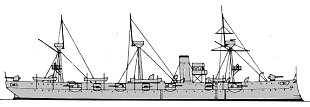
NAVYPEDIA
 Support the project with paypal
Support the project with paypal
Ships
| Name | No | Yard No | Builder | Laid down | Launched | Comp | Fate |
|---|---|---|---|---|---|---|---|
| 千代田 [Chiyoda] | 244 | J & G Thomson, Clydebank, UK | 4.12.1888 | 3.6.1890 | 1.1.1891 | submarine depot ship 1920 |
Technical data
| Displacement normal, t | 2400 |
|---|---|
| Displacement full, t | 2439 |
| Length, m | 94.5 wl 92.1 pp |
| Breadth, m | 12.8 |
| Draught, m | 4.27 |
| No of shafts | 2 |
| Machinery | 2 VTE, 6 locomotive boilers |
| Power, h. p. | 5600 |
| Max speed, kts | 19 |
| Fuel, t | coal 427 |
| Endurance, nm(kts) | 8000(10) |
| Armour, mm | compound - belt: 92 - 82, deck: 35 - 25, CT: 30 |
| Armament | 10 x 1 - 120/40 Armstrong P, 14 x 1 - 47/40 3pdr Hotchkiss Mk I, 3 x 10 - 11.4/94, 3 - 350 TT (1 bow, 2 beam) |
| Complement | 350 |
Standard scale images

Chiyoda 1891
Project history
The Chiyoda was a replacement for the protected cruiser Unebi. The order was placed with a British yard, for several unfortunate mishaps had caused the Japanese to lose faith in French designs. Chiyoda was the first armoured cruiser to be completed for the Japanese Navy, and one of the first to carry an armament of shielded Elswick 120mm guns, well-sited in sponsons on the broadside and as bow and stern chasers. The QF guns gave the Chiyoda a great advantage over contemporary armoured cruisers; the brass cartridges, used instead of the previous silk-cased charges, dispensed with the need for sponging out the breech after each firing. This resulted in an increase in the rate of fire of nearly six times over older guns.
The original design had planned for the ship 10 carry two 320mm Canet guns, but this would have resulted in excessive top weight, so 120mm QF guns were substituted. The armoured belt of chrome steel was narrow, but extended for 60m along the waterline. A total of 84 watertight compartments was incorporated in the design.
Ship protection
1.14m-high 59.2m-long Harvey nickel steel belt protected full length and was 92mm abreast machinery and 82mm at ship ends. Protected deck had 25mm flat and 25mm slopes above machinery and 30mm flat and 35mm slopes at ship ends.
Modernizations
1897-1898: boilers were replaced by 12 Belleville; fighting tops were removed.
Naval service
Chiyoda saw action in the Sino-Japanese and Russo-Japanese wars. On 27 July 1904, she struck a Russian mine off Takhe Bay, but was towed to Dalny where repairs were carried out in time to enable her to take part in the Battle of Tsushima. After 1920 she was used as a submarine depot ship and removed from the operational fleet. She was disarmed in April 1922, converted to TS in 1924, discarded in February 1927 and sunk as target 5.8.1927.
Many thanks to Wolfgang Stöhr for additional information on this page.
 HOME
HOME FIGHTING SHIPS OF THE WORLD
FIGHTING SHIPS OF THE WORLD JAPAN
JAPAN CRUISERS
CRUISERS CHIYODA armoured cruiser (1891)
CHIYODA armoured cruiser (1891)
